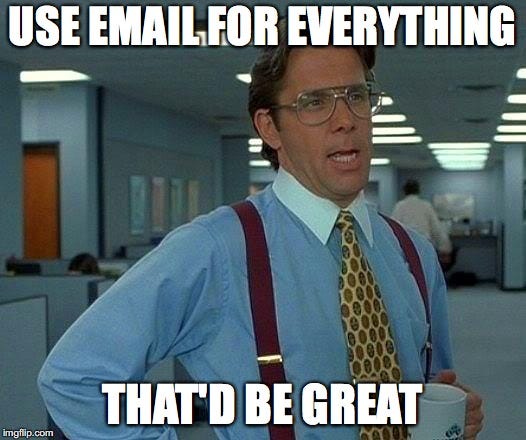Purpose-built document formats in office communication can aid organizational alignment.
In olden times, the Memorandum was the mainstay of organizational communication. It was a way to document something that needed to be shared and remembered; its format held just enough formality to garner attention, but not so much that it felt arduous or overwhelming to produce or receive.
In the age of email, Slack, and lots of social-like information sharing applications, it might seem odd to lament the loss of formats such as the Memo, but the truth is that we’ve lost a lot of useful communications technologies over the last twenty years: most have been replaced by a single, one-size-fits-all form: email.
Four Dimensions in the Communication Space
To see just how much we’ve lost in our transition to email, you’ll need to learn some key communications concepts:
- Synchronous communications require both parties to be present/involved simultaneously, but Asynchronouscommunications do not. A telephone call is a synchronous communication, whereas voicemail is asynchronous.
- Local communications are those that have the option of happening in person. Distant communications are just that: there’s no plans for the parties to see each other. A post-it note left on someone’s desk is a local communication, but a letter sent via post is distant.
- Cardinality is a way to describe the number of people included in the communication. It’s easy to think of communication cardinality in just three ways: One:One (like a private meeting), One:Many (like a presentation or report), Many:Many (like a conference or workshop).
- Lastly, some communications are Ephemeral in that their value disappates as the context changes and time moves on (e.g. comments shared before a meeting, or an announcement that donuts are available in the break room). This is in contrast to Reference communications, which have value over the long term (e.g. policy or process documentation, reports, or ideas for a longer-term project or program.)
Purpose Built vs. Good Enough
Each of these dimensions (synchronicity, locality, cardinality, and ephemerality) is relevant in office communications, and historically we had formats that were purpose built to target specific aspects of these dimensions. (There other, “expert” dimensions to consider as well, but their beyond the concern of most folks.)
Here’s a chart which might help (though it doesn’t even cover ephemerality):

Now… here’s the thing: Email is “good enough” at both local and distant communication. It’s pretty fast too, so it’s possible to have a synchronous conversation in email. (This “not quite real time” type of synchronicity is sometimes called “near time” communication.) And email is also passably effective at all types of cardinalities: I can email just one person, or I can copy in the world to broadcast my missives and/or start a many-to-many conversation. The issue of ephemerality? Well, people have many methods for organizing their email for recall — some set up complex folder systems, some never delete anything and just use the search, and some even schedule emails to come back to them at some point in the future when they’ll need it.
Here’s the result:


Email’s convenience (and its entry-level accessiblity to virtually every level of office worker) has made it the dominant communications form — but one which deeply and relentlessly erodes the effectiveness of organizations.
The casual nature of email often preempts thoughtful consideration and analysis — because it’s just plain easier to share things as is. The goal of communicating takes a backseat to the endorphin trip that comes from pressing send. If they have questions, they’ll reply, right? Similarly, email attachments allow senders to claim that they communicated, with the full knowledge that most attachments go unread. And if you eed to know a policy — or last quarter’s numbers — good luck digging through your email to find it…
This shmear of electronic communications influences meeting styles as well: meetings have devolved into loose, unstructured affairs where participants and presenters never know when they’re reporting, when they’re discussing, or when they’re deciding.
Organizations like Slack etc. seem to see these issues as opportunities, but my sense is that they just want to replace “email for everything” with some other “X for everything”.. and that won’t do.
Purpose-Built Document Formats Can Help With Alignment
I strongly encourage organizations to reduce their use of email and instead structure their communications in a purposeful way.

Quarterly reports —formatted careful… and printed! — get read… and saved.. and referenced.
A bulletin board placed near the coffee machine will get more eyeballs than all the CCs in the world.
Handbooks can collect policies in a clear location for easy reference, and an annual update/release to these handbooks can serve as a useful landmark in the planning calendar.
A good old-fashioned Read File or Tickler File is worth its weight in gold… and it outperforms email all day long.
Last but not least… just for giggles, the next time you have something important to share… send an actual Memorandum. Format it correctly and distribute it in print. Initial it with an actual pen! You’ll be amazed at the attention and response you get — and the alignment and productivity your organization gains.